
The fields in Croan townland, where the Gaffey family farmed.
James Gaffey
This block will be replaced by LeftMenuGaffey (orByrnes) when the page is served from a server.
- Father:
- Daniel GAFFEY
- Mother:
- Mary TORLEY (b c1808)
- Birth:
- 1844, Mayobridge (Clonallan Parish), near Newry, County
Down (Ireland)[1],[2],[3] - Baptism:
- Dec 5 1844 in Clonallon Parish[4]
- Occupation:
- Farmer, agricultural labourer
- Migration to:
- New South Wales on Fitzjames (1860)[5],[6]
- Lived in:
- near Bundarra west of Armidale (1860-1917)[7]
- Death:
- Apr 12 1917 in Inverell, NSW of a cerebral haemorrhage[8]
- Burial:
- Apr 13 1917 in Bundarra Catholic Cemetery[9]
- Marriage:
- Margaret BERRYMAN (Jun 8 1868 in Bundarra near Armidale)
- Children:
- Mary Ann GAFFEY (1870-1872)
- Margaret GAFFEY (b 1872)
- Alice GAFFEY (b 1874)
- Catherine Isabella GAFFEY (b 1876)
- Emily Jane GAFFEY (b 1878)
- Elizabeth H GAFFEY (b 1881)
- Thomas Patrick GAFFEY (1883 - 1949) married Stella Williams, 1921, Sydney
- Elva GAFFEY (b 1885)
- James Daniel Harold GAFFEY (b 1888)
- Ellen GAFFEY (b 1895)
The saga of the Gaffeys in the New England area of New South Wales starts with the arrival there of Irish immigrants, Patrick Gaffey and his brothers, with Patrick the first to make the break from an Ireland just recovering from the blight of the potato famine. The Gaffey boys had grown up on a small rented acreage in Northern Ireland, and they took the opportunity to make new lives for themselves in a new land.
James was the fifth child and fourth son - the register of Clonallon Parish, near Newry in County Down, gives details of his baptism on December 5, 1844 and, given the Catholic tradition of baptism soon after birth, it's more than likely that James was born that year.
James and his brothers and sister would have received their basic
schooling in a small National School attached to the Catholic chapel
in Mayobridge, two kilometres distant from their home. However,
James may not have gone to school at all - official records 50 years
later in Australia show that James signed his name with an "X", and
had to have official documents read to him. [10]
When James was in his early teens, his father died, and the family started to separate - the eldest, Patrick, the first to go to England, working in Bilston, in Staffordshire, then onto Australia with his second wife, Ann.
In 1860, James set out to follow Patrick south, a move encouraged by his older brother, who sponsored him and his brother William on the Fitzjames. [Their mother Mary and their sister, Mary Ann were also supposed to migrate to NSW, but their mother died in Bilston, Staffordshire before the departure date of the voyage, and Mary Ann stayed on in England, married and died there]. James' occupation is noted on his immigration papers as 'labourer'. (The spelling GAFFNEY was used in records of the immigrant ship). James, William and later Daniel and Bernard all settled near Patrick in the Bundarra area. According to Post Office directories of the time, Patrick, James and Daniel all worked as shepherds for a period.
James met, and married in 1868, Margaret Berryman, the Australian-born
19-year-old daughter of an English convict and a free Irish girl (her
mother was herself the daughter of an Irish convict). The Marriage
certificate was very vague on details, but the ceremony was carried
out in Bundarra "according to the Rites of the Church of Rome",
probably in a sawn timber building completed in the village in 1862.
The pastoral needs of Bundarra's Catholic population were catered for
by a travelling priest, Father J Davis, who conducted services and
visited homes in the Upper Gwydir area before a resident priest was
appointed in 1881. One local history of the area notes that before
1881, Father Davis used to extract teeth for his parishioners, but
during his absence, sufferers had to rely on the local blacksmith.[11]
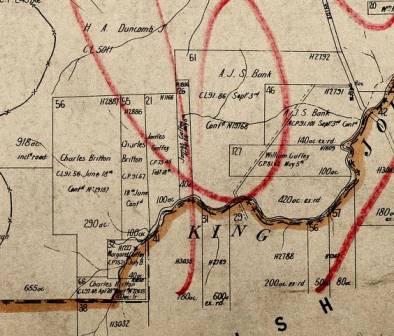
An 1880s map showing ownership of land south of Bundarra. James Gaffey's two selections on the northern side of King John's Creek is just to the left of centre, that of his brother William further to the east, while his daughter Margaret also had a smaller selection in her name (a square selection crossing the Creek, just southwest of James' holding).
All the Gaffey selections, totalling 280 acres, had frontage to King John's Creek, a tributary of the Gwydir River, which runs northwards through Bundarra.
James' first-born child, a girl Mary Ann, born in May 1870, died just over two years later from "accidental burning"[12]. James and Margaret went on to have another nine children, including Thomas in 1883. James' children took up many and varied occupations, including farming, butcher shops and hotels. [His daughter Alice and her husband John Twoomey owned several hotels including Tattersalls Hotel at Hillgrove (east of Armidale), the Imperial Hotel at Quirindi and the Prince of Wales Hotel in Newcastle (c1923), while another two daughters owned hotels at Inverell and Hillgrove .
James' eldest daughter Margaret married into the Baldwin family. Her father-in-law, William Baldwin, had earlier achieved some notoriety when, as the village blacksmith (it's not known if he was the one who also doubled as the emergency dentist!) made a special set of horse shoes for a horse belonging to the outlaw Thunderbolt.
They were made with rivets in the heels, so that when Thunderbolt wanted to come to town for provisions, an extra section of iron could be joined in at the back of the shoe, making it a complete oval. This scheme was devised to confuse the trackers employed by the police. One of these shoes is in Smith's Museum at Tingha.
In 1875, James had acquired, by conditional purchase, at least 140 acres of land, which he sold 10 years later to a grazier neighbour for £210.[15] In 1885, he was also recorded as holding 800 acres at Black Mountain, with three horses, five cattle, and 460 sheep.
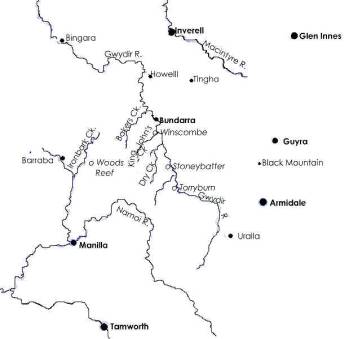
The Gaffey area of northern New South Wales
In the mid 1880s, James and his by now large family, moved on to a
property at Ironbark Creek, further to the west at Barraba, south of
Bingara. There they stayed until the turn of the new century, when,
pulling up their roots once again, they moved for a final time to
Howell, a mining village south of Inverell.
This village had already suffered one boom-and-bust before James and his family arrived there around 1900, and big changes had already taken place to establish a stannite mine employing 150 men. No trace remains today (2000) of Howell, established originally under the name of Bora Creek, which sprang up to support the mining of silver, lead, copper and zinc at the Conrad Mine. The small village grew into a "roisterous little town".
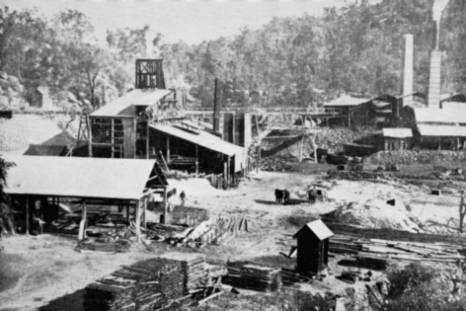
The stannite mine at Howell
Despite his having owned or occupied parcels of land at Black Mountain, Bundarra, and Bingara, James became a general labourer at Howell, and since the main source of employment in the area from 1900 onwards was at the stannite mine, it's possible James worked at the mine before going on the old age pension.
One of James' daughters, Elva, married Raymond Skippen, the son of a local businessman, Nat Skippen. Nat Skippen owned Howell's big two-storey hotel, where Raymond worked as a barman. Nat Skippen also had an interest in the Conrad Mine, and given the possibility of some insider knowledge, it's not too surprising that he sold the hotel in the year before the mine went into liquidation.
Considering that nothing exists there today (2000), it's hard to believe that 100 years earlier, Howell boasted two general stores, two butchers' shops, two bakers' shops, cafés, barbers, a blacksmith and its own local newspaper. After the collapse of the mine, the tiny village dwindled, with most residents (and, in many cases. their weatherboard houses) moving onto the more resilient town of Tingha, 20 kilometres away. However, James and his family stayed on in Howell.
James suffered a cerebral haemorrhage in April 1917 and died three days later in Inverell hospital. He had outlived all his brothers: the original pioneer Patrick dying first in 1901. It appears Bernard had moved to Sydney, where the death of a Bernard Gaffey is recorded at the Gladesville Hospital for the Insane in 1910. William, apparently inebriated at the time, drowned in 1913 in the Gwydir River, which flows through Bundarra. Daniel also stayed on in the New England, dying at Bundarra the year before James.
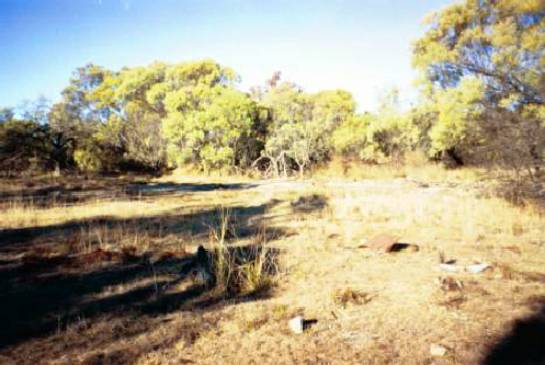
The surveyed town of Howell, with cobbled streets, and houses for 1500 people, can barely be found now - only the occasional garden shrub and fruit tree, pile and brick and rubbish heap remain as reminders of Inverell's "Broken Hill".[18]
(right) The Gaffey family graves
at the cemetery at Bundarra in
northern New South Wales
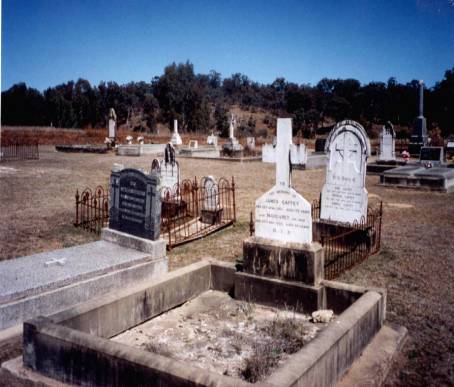
[1]There are various
conflicting versions of James' birthdate::
1836 Birth certificate for his daughter Margaret gives
his age as 36 in 1872.
1844 Gravestone inscription (Bundarra cemetery)
1845 James' death certificate
1847 Shipping records (James' age on arrival in Sydney in
1860 given as 13)
[2] Information from Mrs. Jean McDonnell of Ettalong, Irish Families in Australia and New Zealand Rev. Vol 2 Eades-Lyttle 1788-1985 ed by Coffey & Morgan. Vol 2, page 55
[3] Death certificate of James Gaffey.
[4] Clonallan Parish Baptismal Records, Ireland
[5] James' death certificate
[6] NSW Govt. Archives. Index to assisted immigrants arriving Sydney and Newcastle 1844-1859, (1860-1890?) reel 2139
[7] NSW Marriage Certificate (James & Margaret)
[8] James Gaffey's death certificate
[9] As above
[10] Transfer of Conditional Purchase, Book 341, No 574, 1885, Inverell.
[11] Claire Scholfield, Bundarra: Stepping Stone of the Gwydir, Schofield, Inverell, 1979
[12] Mary Ann's death certificate